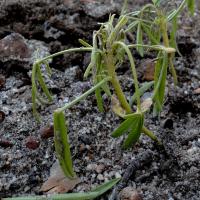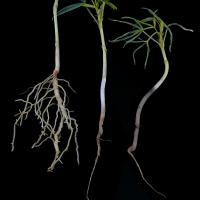Diagnosing glyphosate damage in narrow-leafed lupins
Glyphosate is a systemic knockdown herbicide that is used extensively for brown fallow, summer weed or pre-seeding weed control, or selective weed control in glyphosate resistant crops.
What to look for
- Limp discoloured plants that may slowly die.
- Direct spray damage is uniformly distributed but varies with spray coverage on overlaps or boom turns.
- Spray drift damage is worse near the source.
Paddock
- The first sign is pale new growth.
- Plants then wilt and die.
- Dying seedlings develop a mushy hypocotyl.
Plant
What else could it be
| Condition | Similarities | Differences |
|---|---|---|
| Diagnosing group B herbicide damage in narrow-leafed lupins | Yellowing of new leaves | Plants do not wilt and they take much longer to die back. |
| Diagnosing sulphur deficiency in narrow-leafed lupins | Pale small new leaves | Plants do not wilt and die. |
| Diagnosing iron deficiency in narrow-leafed lupins | Pale small new leaves. | Plants do not wilt and die. |
| Diagnosing zinc deficiency in narrow-leafed lupins | Stunted plants with pale new leaves. | Plants do not wilt and die. |
Management strategies
- No treatment - plants then wilt and die.
Further information
Page last updated: Thursday, 5 February 2015 - 9:53am




